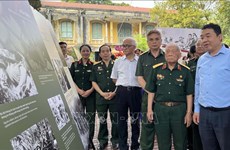Exhibition revels in diversity
The cultures and diversity of Southeast Asia are on display in a new
exhibition of lacquerware and Indonesian glass paintings entitled “A
Glimpse of Southeast Asia” that opens at the Vietnam Museum of Ethnology
in Hanoi.
The cultures and diversity of Southeast Asia are on display in a new
exhibition of lacquerware and Indonesian glass paintings entitled “A
Glimpse of Southeast Asia” that opens at the Vietnam Museum of Ethnology
in Hanoi.
The art of glass painting originated in Europe but was introduced to Indonesia in the early 20th century by the Dutch, flourished there during the 1930s. Artists paint on the reverse side of the glass, with the first stroke on the glass seen in the foreground of the image as paintings are viewed through the glass.
The new exhibition aimed to increase public understanding of the links among Vietnamese ethnic groups and those of Southeast Asia as a whole, which together form both a unity and a diversity of cultures, according to museum director Vo Quang Trong.
In preparation for the exhibition, museum staff travelled throughout the region collecting objects and materials, added Vo.
"We were met with excitement and collaboration from cultural institutions, museums, researchers, private collectors, and many people who are keen to preserve their cultures," he said.
The collections were particularly enriched by objects donated by Prof Kaneko Kazushige from Japan , Prof Le Thanh Khoi from France , and Rosalia Sciortino and O'ong Maryono from Italy . The resulting exhibition is based on a Vietnamese-French project entitled Enhancement of Vietnamese Museum's Heritage, organised by the French Embassy in Vietnam and the Vietnam Academy of Social Sciences.
Since 2005, French experts have participated in designing and giving professional advice on exhibit space. They have also worked with the museum staff on selecting objects, photographs and films, making suggestions, editing texts and captions, shaping the catalogue and designing graphic forms, said Christine Hemmet, curator of France 's Branly Museum .
A Glimpse on Southeast Asia also celebrates the occasion of the museum's 15th anniversary and will run through October 5 of next year. With the opening of the Kite Building , currently under construction, the exhibition will be expanded to include costumes and other exhibits on the religion, performing arts and social lives of the region's ethnic groups./.
The art of glass painting originated in Europe but was introduced to Indonesia in the early 20th century by the Dutch, flourished there during the 1930s. Artists paint on the reverse side of the glass, with the first stroke on the glass seen in the foreground of the image as paintings are viewed through the glass.
The new exhibition aimed to increase public understanding of the links among Vietnamese ethnic groups and those of Southeast Asia as a whole, which together form both a unity and a diversity of cultures, according to museum director Vo Quang Trong.
In preparation for the exhibition, museum staff travelled throughout the region collecting objects and materials, added Vo.
"We were met with excitement and collaboration from cultural institutions, museums, researchers, private collectors, and many people who are keen to preserve their cultures," he said.
The collections were particularly enriched by objects donated by Prof Kaneko Kazushige from Japan , Prof Le Thanh Khoi from France , and Rosalia Sciortino and O'ong Maryono from Italy . The resulting exhibition is based on a Vietnamese-French project entitled Enhancement of Vietnamese Museum's Heritage, organised by the French Embassy in Vietnam and the Vietnam Academy of Social Sciences.
Since 2005, French experts have participated in designing and giving professional advice on exhibit space. They have also worked with the museum staff on selecting objects, photographs and films, making suggestions, editing texts and captions, shaping the catalogue and designing graphic forms, said Christine Hemmet, curator of France 's Branly Museum .
A Glimpse on Southeast Asia also celebrates the occasion of the museum's 15th anniversary and will run through October 5 of next year. With the opening of the Kite Building , currently under construction, the exhibition will be expanded to include costumes and other exhibits on the religion, performing arts and social lives of the region's ethnic groups./.













